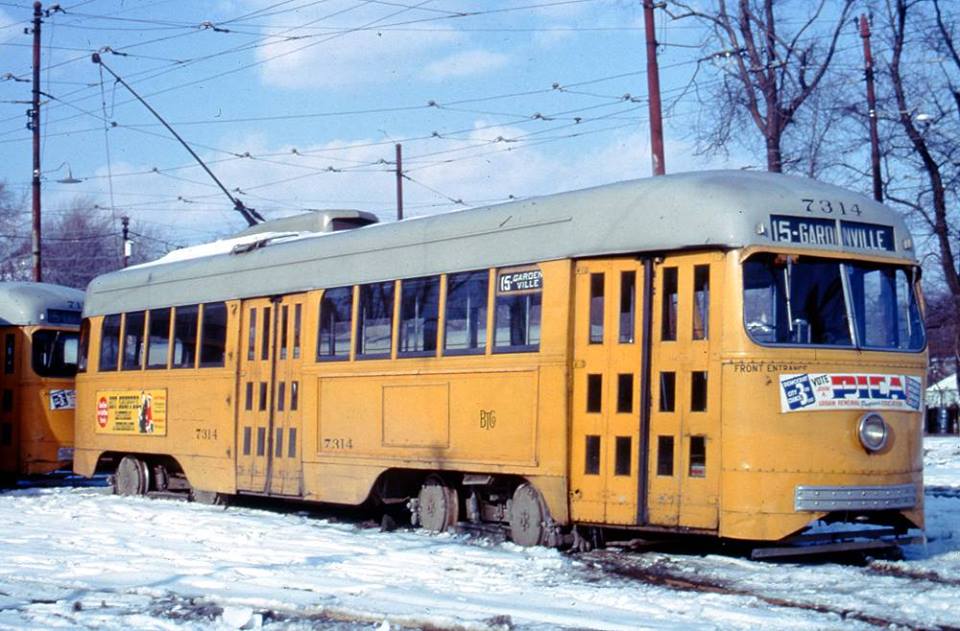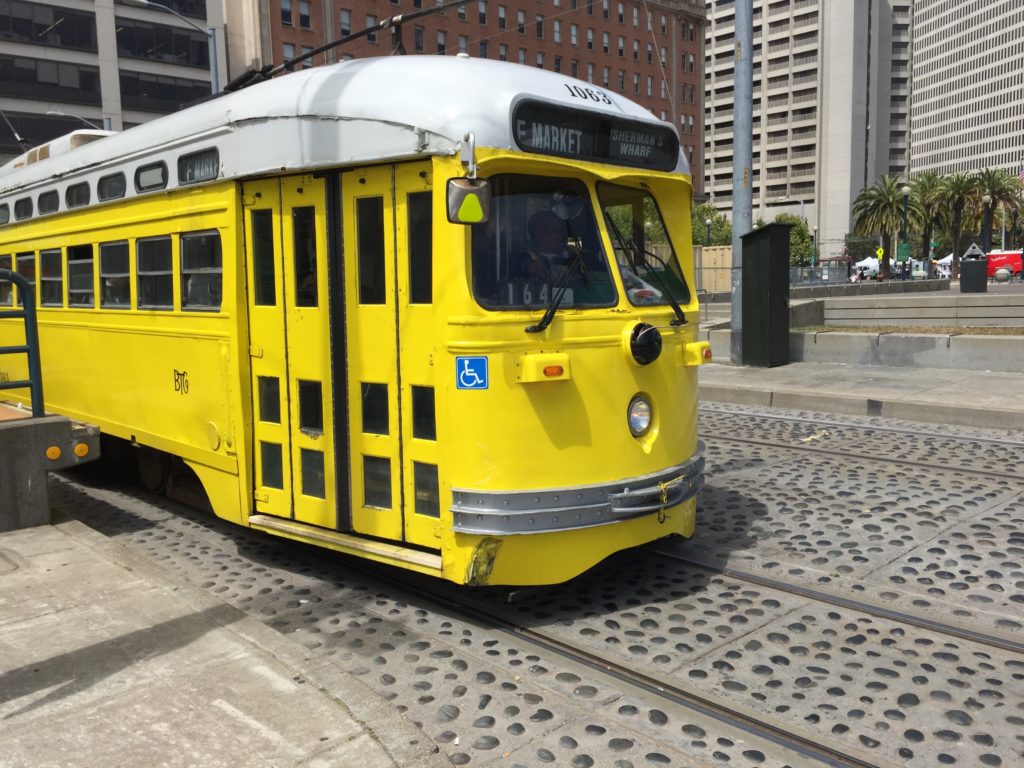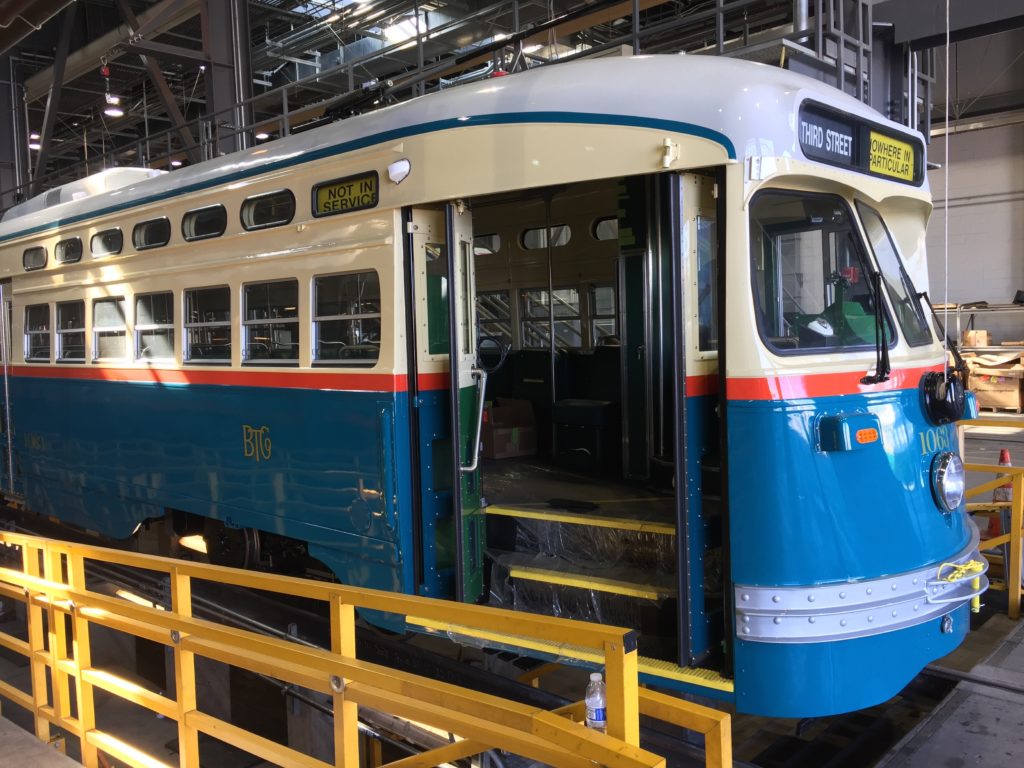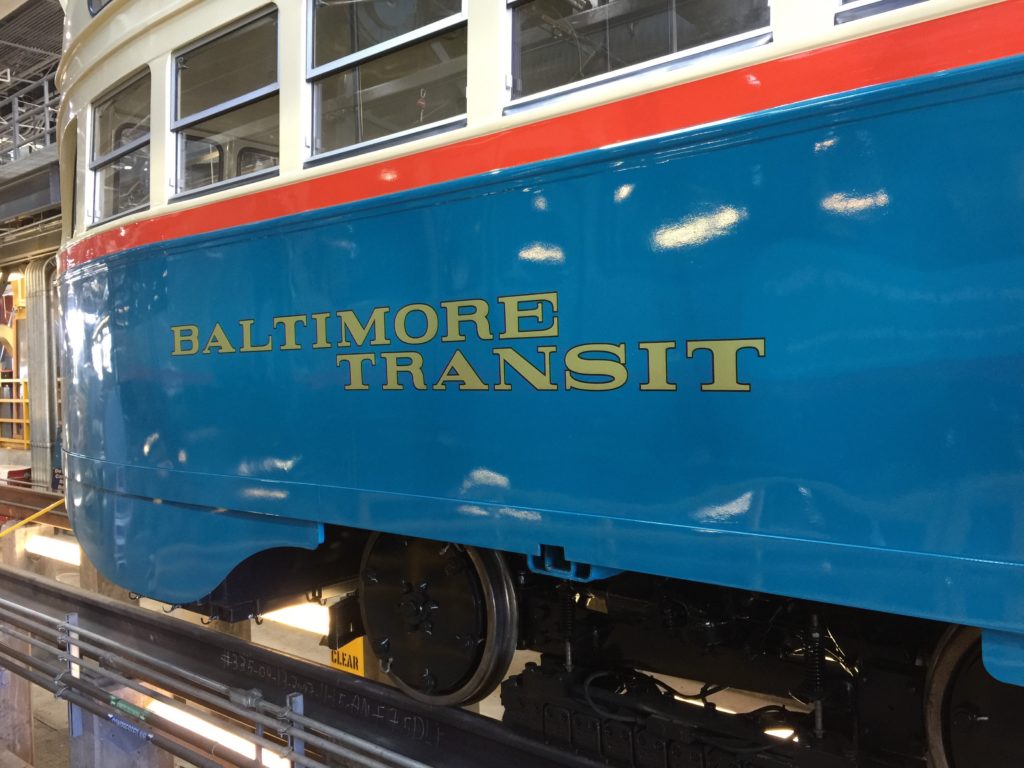Of all the comments we’ve received about Muni’s restored PCC streetcars over the past 30 years, nothing comes close to carping about colors. “You’re half a shade off there, you know.” “I can’t believe you didn’t get that green right.” And on and on and on.
Which is why you can call this a pre-emptive post. All you Baltimore Transit experts who look at the photos in this post with your fingers twitching to launch a tirade, step back from the keyboard and read the rest of the post first.
In a lifetime of photography, I (MSR President Rick Laubscher) have never seen such an odd color shift from the actual as I got today in photographing newly restored PCC 1063, honoring Baltimore Transit, which arrived at Muni Metro East first thing this morning.
When i first laid eyes on the 1063, just inside the shop, the color seemed to be accurate — a blue-green some call teal, some cyan. But when I photographed it, the result is way more blue than it really is, as seems evident in my photos above and below. (Also, the orange belt rail looks redder than it actually is.)
I had seen earlier shots of the car, taken at Brookville Equipment Company before it left for San Francisco, that concerned me because the body of the car, which is supposed to be a very unusual teal tone, looked flat-out blue. Which would be wrong. But another photo from Brookville looked just right, and we were told the car actually matched the sample panel we created after consultation with the Baltimore Streetcar Museum, which restored authentic Baltimore Transit car 7407. Both shots that looked too blue, in SF and Brookville, were taken indoors, so maybe it’s the temperature of the artificial lighting affecting the camera sensors. All I can say is that when I looked at it with my own eyes, it looks correct. Weird.
The right color was even more important because when it was first restored for Muni, in the early 1990s, Muni only allowed eight colors to be used in the palette for all the PCCs. Consequently, a number of the restored cars were indeed a “half-shade off”, including the 1063. (The actual Baltimore paint scheme is just below in the snow, with 1063 in its 1990s paint just below that.)

 Anyway, on the recommendation of several people we respect, including then-head of Muni historic rail maintenance Karl Johnson, we opted for the original Baltimore PCC scheme, dating back to 1936. In working with the museum in Baltimore, we were told that photographs of their 7407 might appear to show silver lettering and logos, but the originals were actually gold, so we made them that way.
Anyway, on the recommendation of several people we respect, including then-head of Muni historic rail maintenance Karl Johnson, we opted for the original Baltimore PCC scheme, dating back to 1936. In working with the museum in Baltimore, we were told that photographs of their 7407 might appear to show silver lettering and logos, but the originals were actually gold, so we made them that way.
Without exact, modern paint codes, which we could not obtain for the 1063’s teal, you have to do the best you can. The different temperatures of old film don’t make it easier. The color photos of the Baltimore yellow/orange online, for example, run the gamut from almost as yellow as 1063 used to look to as orange as Muni’s Milan trams. And it’s important to remember that traction companies often mixed their own paint, and some cars came out of the repair shop in a slightly different shade than it went in. In the days of old lead-based paints, oxidation played a major role as well, which is why some old-timers swear a particular paint scheme is “off” when they’re remembering the oxidized shade, not the shiny color it wore when factory fresh.
Whatever. Car 1063 is here; it looks as good inside and out as the six cars already delivered in this restoration contract (1051, 1055, 1056, 1059, 1060, 1062). Don’t know when it will hit the streets for testing and its 1000-mile testing before being accepted for service, since 1055 is ahead of it. When it’s out, we expect to see a whole lot of photos in different lighting conditions. And when people see it in person, on the street, not through an internet post, it’s going to look right.
By the way, the 1063 came out on the return trip that took Pacific Electric 1061 to Brookville for rehab. No additional cars left today.


As a long time Pacific Electric fan, who used to live next to a PE line, I can testify on how photos taken 60 or 70 years ago can be all over the spectrum when it comes to accurately depicting how the cars looked A) right out of the paint shop, and B) after ten or fifteen years in the sun. That said, I had to defend the colors on 1061 to some Red Car fans who didn’t like the orange on the decorative stripes, saying I like the car and enjoy seeing my “home road” honored by Muni. The admittedly incorrect orange is all they had available at the time. When it comes back from rehab, the stripes will probably more like Boston Elevated orange and be much more authentic.
I have looked at 1063’s paint in the sun and at 7407’s paint in the sun, and taking into account for fading, find that 1063’s I pretty darn close. I have some photos of 7407 clean and sparkling and the blue Is pretty much the same in direct strong sunlight. There is no one alive (well, almost no one) who could exactly remember what the1936 St. Louis PCCs actually looked like. I would have liked to see wings though as most of Baltimore’s cars had them.
John, thanks. The absence of the chrome headlight wings may be a mistake. We (Market Street Railway) weren’t involved in the original liveries. The 1063 in yellow didn’t have them, and we were so consumed on getting the original colors right that we didn’t notice that wings weren’t specified. We’ll see if we can get that fixed.